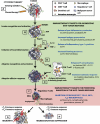Immune microenvironments in solid tumors: new targets for therapy
- PMID: 22190457
- PMCID: PMC3248678
- DOI: 10.1101/gad.169029.111
Immune microenvironments in solid tumors: new targets for therapy
Abstract
Leukocytes and their soluble mediators play important regulatory roles in all aspects of solid tumor development. While immunotherapeutic strategies have conceptually held clinical promise, with the exception of a small percentage of patients, they have failed to demonstrate effective, consistent, and durable anti-cancer responses. Several subtypes of leukocytes that commonly infiltrate solid tumors harbor immunosuppressive activity and undoubtedly restrict the effectiveness of these strategies. Several of these same immune cells also foster tumor development by expression of potent protumor mediators. Given recent evidence revealing that immune-based mechanisms regulate the response to conventional cytotoxic therapy, it seems reasonable to speculate that tumor progression could be effectively diminished by combining cytotoxic strategies with therapies that blunt protumor immune-based effectors and/or neutralize those that instead impede development of desired anti-tumor immunity, thus providing synergistic effects between traditional cytotoxic and immune-modulatory approaches.
© 2011 by Cold Spring Harbor Laboratory Press
Figures

References
-
- Albert ML, Sauter B, Bhardwaj N 1998. Dendritic cells acquire antigen from apoptotic cells and induce class I-restricted CTLs. Nature 392: 86–89 - PubMed
-
- Almand B, Clark JI, Nikitina E, van Beynen J, English NR, Knight SC, Carbone DP, Gabrilovich DI 2001. Increased production of immature myeloid cells in cancer patients: A mechanism of immunosuppression in cancer. J Immunol 166: 678–689 - PubMed
-
- Amato RJ, Hawkins RE, Kaufman HL, Thompson JA, Tomczak P, Szczylik C, McDonald M, Eastty S, Shingler WH, de Belin J, et al. 2010. Vaccination of metastatic renal cancer patients with MVA-5T4: A randomized, double-blind, placebo-controlled phase III study. Clin Cancer Res 16: 5539–5547 - PubMed
Publication types
MeSH terms
Grants and funding
LinkOut - more resources
Full Text Sources
Other Literature Sources
